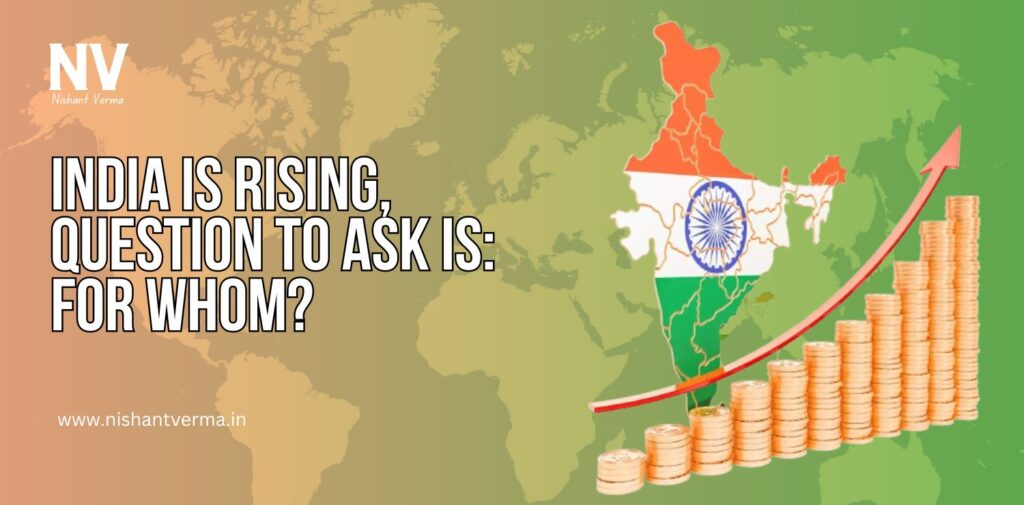India is often celebrated for its rapid economic growth, its burgeoning tech industry, and its rising status on the global stage. The narrative of a vibrant, expanding economy is compelling, especially as the country continues to transform its global economic standing. Yet, behind the headlines and dazzling statistics, a critical question remains: who is actually benefiting from India’s rise? The disparity between the wealthy and the rest of the population raises concerns about the inclusivity of this economic boom.
The Wealth Divide: A Snapshot
To understand the extent of inequality in India, let’s delve into some striking statistics. The top 0.01% of earners possess a staggering 22.2% of the nation’s wealth. This figure is not only eye-opening but highlights a growing chasm between the ultra-rich and the rest of the population. For context, the top 0.01% in the United States, a country often criticized for its economic disparity, hold about 12.5% of the nation. While both countries exhibit significant wealth concentration at the top, the figure underscores a more extreme concentration within its elite.
This contrast prompts a deeper examination: as India ascends economically, are the benefits distributed fairly, or is the prosperity largely confined to a small fraction of the population?
The Growth Narrative
India’s economic growth has been impressive, with a rapid expansion of its GDP and significant foreign investment. The nation has become a global hub for technology and innovation, and its young, dynamic workforce is often touted as a major asset. The rise of major corporations and a booming start-up ecosystem further bolster the image of a thriving economy. Yet, this growth narrative often masks the uneven distribution of wealth.

In metropolitan areas like Mumbai and Bengaluru, opulent lifestyles and luxury real estate are prevalent among the wealthy, while vast segments of the population continue to grapple with poverty and limited access to basic services. Rural areas and smaller towns lag behind, with less access to the fruits of this economic progress. This disparity is reflected in the wealth distribution data, where a significant portion of the country’s wealth is concentrated in the hands of a few.
The Social Implications
The concentration of wealth among the elite has far-reaching social implications. When a small segment of the population controls a substantial portion of the nation’s wealth, it can exacerbate social divides and create a sense of disenfranchisement among the majority. Inequality affects not only economic stability but also social cohesion and political stability. It can lead to a lack of trust in institutions and undermine efforts to achieve a more inclusive society.
Educational and healthcare opportunities, crucial components for upward mobility, are often skewed in favor of the wealthy. Access to quality education and advanced medical care remains limited for lower-income groups, perpetuating a cycle of disadvantage. The disparity in wealth translates into unequal opportunities, further entrenching social and economic divides.
Government and Policy Responses
Addressing wealth inequality requires a multifaceted approach. The Indian government has implemented various policies aimed at poverty alleviation and improving access to education and healthcare. Schemes like the Pradhan Mantri Awas Yojana (housing for all) and the Ayushman Bharat health insurance scheme are designed to provide support to lower-income families. However, the effectiveness of these programs often depends on their implementation and the efficiency of local governance.

Moreover, there is a growing call for reforms to address the root causes of inequality. Progressive taxation, enhanced social safety nets, and investment in infrastructure and education could help redistribute wealth more equitably. Encouraging corporate social responsibility and promoting fair labor practices are also crucial steps towards a more balanced economic landscape.
The Role of the Private Sector in Indian Economy
The private sector, particularly the booming tech industry, plays a significant role in shaping its economic future. While the industry has created numerous job opportunities and contributed to its growth, it also reflects and sometimes exacerbates existing inequalities. High-paying jobs in technology and finance are often concentrated in major cities, leaving rural and less developed areas with limited benefits.

There is an opportunity for the private sector to contribute to a more inclusive economy by investing in regional development, supporting educational initiatives, and fostering entrepreneurship in underserved areas. Companies can also engage in social impact programs that address pressing issues like healthcare, education, and infrastructure.
The Global Perspective
India’s experience is not unique. Many rapidly developing economies face similar challenges of wealth concentration and inequality. The global trend of increasing wealth disparity is evident in various countries, prompting international organizations and policymakers to explore solutions for more equitable growth. India, with its large and diverse population, presents both opportunities and challenges in this global context.
Looking Ahead
As India continues on its path of economic growth, it is essential to ensure that the benefits are widely shared. Addressing wealth inequality is not just about improving statistics; it’s about fostering a more inclusive society where opportunities are accessible to all. The narrative of rise should include not only the success stories of its elite but also the voices and experiences of those who remain on the margins.
In conclusion, the question of who truly benefits from India’s economic ascent is crucial. While the nation enjoys significant achievements, the challenge lies in creating a more equitable distribution of wealth. Ensuring that the rising tide lifts all boats, rather than just a select few, will be key to India’s continued growth and stability in the years to come.




